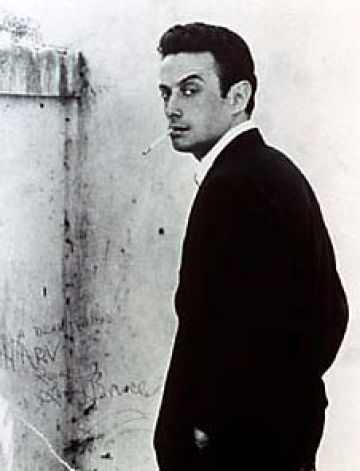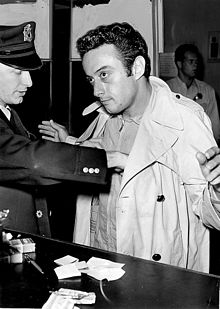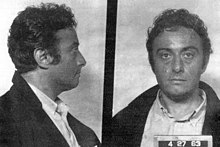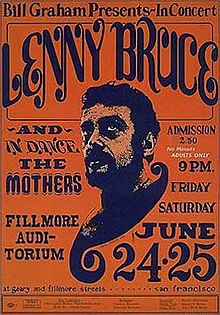 Leonard Alfred Schneider (October 13, 1925 – August 3, 1966), better known by his stage name Lenny Bruce, was an American stand-up comedian, social critic, satirist, and screenwriter. He was renowned for his open, free-style and critical form of comedy which integrated satire, politics, religion, sex, and vulgarity. His 1964 conviction in an obscenitytrial was followed by a posthumous pardon, the first in New York State history, by then-Governor George Pataki in 2003. He paved the way for future outspoken counterculture-era comedians, and his trial for obscenity is seen as a landmark for freedom of speech in the United States.
Leonard Alfred Schneider (October 13, 1925 – August 3, 1966), better known by his stage name Lenny Bruce, was an American stand-up comedian, social critic, satirist, and screenwriter. He was renowned for his open, free-style and critical form of comedy which integrated satire, politics, religion, sex, and vulgarity. His 1964 conviction in an obscenitytrial was followed by a posthumous pardon, the first in New York State history, by then-Governor George Pataki in 2003. He paved the way for future outspoken counterculture-era comedians, and his trial for obscenity is seen as a landmark for freedom of speech in the United States.
Early life
Lenny Bruce was born Leonard Alfred Schneider in Mineola, New York, grew up in nearby Bellmore, and attended Wellington C. Mepham High School. His parents divorced when he was young, and Lenny lived with various relatives over the next decade. His British-born father, Myron (Mickey) Schneider, was a shoe clerk and Lenny saw him very infrequently. Bruce’s mother, Sally Marr (real name Sadie Schneider, born Sadie Kitchenberg), was a stage performer and had an enormous influence on Bruce’s career.[15]
After spending time working on a farm, Bruce joined the United States Navy at the age of 16 in 1942, and saw active duty during World War II aboard the USS Brooklyn (CL-40) fighting in Northern Africa, Palermo, Italy in 1943 and Anzio, Italy in 1944. In May 1945, after a comedic performance for his ship-mates in which he was dressed in drag, his commanding officers became upset. He defiantly convinced his ship’s medical officer that he was experiencing homosexual urges.[16] This led to his Dishonorable Discharge in July 1945. However, he had not admitted to or been found guilty of any breach of naval regulations and successfully applied to have his discharge changed to “Under Honorable Conditions … by reason of unsuitability for the naval service”.[17]In 1959, while taping the first episode of Hugh Hefner’s Playboy’s Penthouse, Bruce talked about his Navy experience and showed a tattoo he received in Malta in 1942.[18]
After a short stint in California spent living with his father, Bruce settled in New York City, hoping to establish himself as a comedian. However, he found it difficult to differentiate himself from the thousands of other show business hopefuls who populated the city. One locale where they congregated was Hanson’s, the diner where Bruce first met the comedian Joe Ancis,[1] who had a profound influence on his approach to comedy. Many of Bruce’s later routines reflected his meticulous schooling at the hands of Ancis.[19] According to Bruce’s biographer, Albert Goldman, Ancis’ humor involved stream-of-consciousness sexual fantasies, references to jazz, and stories of Jewish domesticity.[20]
Lenny took the stage as “Lenny Marsalle” one evening at the Victory Club, as a stand-in master of ceremonies for one of his mother’s shows. His ad-libs earned him some laughs. Soon afterward, in 1947, just after changing his last name to Bruce, he earned $12 and a free spaghetti dinner for his first stand-up performance in Brooklyn, New York.[21] He was later a guest — and was introduced by his mother, who called herself “Sally Bruce” — on the Arthur Godfrey’s Talent Scouts radio program, doing a Sid Caesar-inspired bit “The Bavarian Mimic” featuring impressions of American movie stars (e.g., Humphrey Bogart, James Cagney, and Edward G. Robinson).[22]
Career
Bruce’s early comedy career included writing the screenplays for Dance Hall Racket in 1953, which featured Bruce, his wife, Honey Harlow, and mother, Sally Marr, in roles; Dream Follies in 1954, a low-budget burlesque romp; and a children’s film, The Rocket Man, in 1954. He also released four albums of original material on Berkeley-based Fantasy Records, with rants, comic routines, and satirical interviews on the themes that made him famous: jazz, moral philosophy, politics, patriotism, religion, law, race, abortion, drugs, the Ku Klux Klan, and Jewishness. These albums were later compiled and re-released as The Lenny Bruce Originals. Two later records were produced and sold by Bruce himself, including a 10-inch album of the 1961 San Francisco performances that started his legal troubles. Starting in the late 1950s, other unissued Bruce material was released by Alan Douglas, Frank Zappa and Phil Spector, as well as Fantasy. Bruce developed the complexity and tone of his material in Enrico Banducci‘s North Beach nightclub, “The hungry i,” where Mort Sahl had earlier made a name for himself.
Branded a “sick comic” – though it was the perceived “sickness” of modern society that he was railing about – Lenny was essentially blacklisted from television, and, when he did appear thanks to sympathetic fans like Steve Allen or Hugh Hefner, it was with great concessions to Broadcast Standards and Practices.[23] Jokes that might offend, like a bit on airplane glue-sniffing teens done live for “The Steve Allen Show” in 1959, had to be typed out and pre-approved by network officials.
His growing fame led to appearances on the nationally televised Steve Allen Show, where he made his debut with an unscripted comment on the recent marriage of Elizabeth Taylor to Eddie Fisher, wondering, “will Elizabeth Taylor become bat mitzvah?”[24] On February 3, 1961, in the midst of a severe blizzard, he gave a famous performance at Carnegie Hall in New York. It was recorded and later released as a three-disc set, titled The Carnegie Hall Concert. In the liner notes, Albert Goldmandescribed it as follows:
This was the moment that an obscure yet rapidly rising young comedian named Lenny Bruce chose to give one of the greatest performances of his career. … The performance contained in this album is that of a child of the jazz age. Lenny worshipped the gods of Spontaneity, Candor and Free Association. He fancied himself an oral jazzman. His ideal was to walk out there like Charlie Parker, take that mike in his hand like a horn and blow, blow, blow everything that came into his head just as it came into his head with nothing censored, nothing translated, nothing mediated, until he was pure mind, pure head sending out brainwaves like radio waves into the heads of every man and woman seated in that vast hall. Sending, sending, sending, he would finally reach a point of clairvoyance where he was no longer a performer but rather a medium transmitting messages that just came to him from out there — from recall, fantasy, prophecy.
A point at which, like the practitioners of automatic writing, his tongue would outrun his mind and he would be saying things he didn’t plan to say, things that surprised, delighted him, cracked him up — as if he were a spectator at his own performance!
Personal life
Bruce met his future wife, Honey Harlow, a stripper from Baltimore, Maryland, in 1951. They were married that same year, and Bruce was determined to have her end her work as a stripper.[25]
In 1953, Bruce and Harlow eventually left New York for the West Coast, where they got work as a double act at the Cup and Saucer in Los Angeles, California. Bruce then went on to join the bill at the club Strip City. Harlow found employment at the Colony Club, which was widely known to be the best burlesque club in Los Angeles at the time.[26]
In late 1954, Bruce left Strip City and found work within the San Fernando Valley at a variety of strip clubs. As the master of ceremonies, his job was to introduce the strippers while performing his own ever-evolving material. The clubs of the Valley provided the perfect environment for Bruce to create new routines: according to Bruce’s primary biographer, Albert Goldman, it was “precisely at the moment when he sank to the bottom of the barrel and started working the places that were the lowest of the low” that he suddenly broke free of “all the restraints and inhibitions and disabilities that formerly had kept him just mediocre and began to blow with a spontaneous freedom and resourcefulness that resembled the style and inspiration of his new friends and admirers, the jazz musicians of the modernist school.”[27]
Honey and Lenny’s daughter Kitty Bruce was born in 1955.[28] He had an affair with the jazz singer Annie Ross in the late 1950s.[29] In 1959, Lenny’s divorce from Honey was finalized.[30]
Bruce dated actress Faye Dunaway for a time in the 1960s. [30]
Legal troubles
Obscenity arrests
On October 4, 1961, Bruce was arrested for obscenity[32] at the Jazz Workshop in San Francisco; he had used the word cocksucker and riffed that “to is a preposition, come is a verb“, that the sexual context of come is so common that it bears no weight, and that if someone hearing it becomes upset, he “probably can’t come”.[33] Although the jury acquitted him, other law enforcement agencies began monitoring his appearances, resulting in frequent arrests under charges of obscenity.
Bruce was arrested again in 1961, in Philadelphia, for drug possession and again in Los Angeles, California, two years later. The Los Angeles arrest took place in then-unincorporated West Hollywood, and the arresting officer was a young deputy named Sherman Block, who would later become County Sheriff. The specification this time was that the comedian had used the word schmuck, an insulting Yiddish term that is an obscene term for penis.[34]
On December 5, 1962, Bruce was arrested at the legendary Gate of Horn folk club in Chicago.[35] The same year he played at Peter Cook‘s The Establishment Club in London, and a year later in April, he was barred from entering England by the Home Office as an “undesirable alien”.[36]
In April 1964, he appeared twice at the Cafe Au Go Go in Greenwich Village with undercover police detectives in the audience. He was arrested along with the club owners, Howard and Elly Solomon, who were arrested for allowing an obscene performance to take place. On both occasions, he was arrested after leaving the stage, the complaints again pertaining to his use of various obscenities.[37]
A three-judge panel presided over his widely publicized six-month trial, prosecuted by Manhattan Assistant D.A. Richard Kuh, with Ephraim London and Martin Garbus as the defense attorneys. Bruce and club owner Howard Solomon were both found guilty of obscenity on November 4, 1964. The conviction was announced despite positive testimony and petitions of support from – among other artists, writers and educators – Woody Allen, Bob Dylan, Jules Feiffer, Allen Ginsberg, Norman Mailer, William Styron, and James Baldwin, and Manhattan journalist and television personality Dorothy Kilgallen and sociologist Herbert Gans.[38] Bruce was sentenced, on December 21, 1964, to four months in a workhouse; he was set free on bail during the appeals process and died before the appeal was decided. Solomon later saw his conviction overturned; Bruce, who died before the decision, never had his conviction stricken.[39] Bruce later received a full posthumous gubernatorial pardon.
Later years
Despite his prominence as a comedian, Bruce appeared on network television only six times in his life.[40] In his later club performances Bruce was known for relating the details of his encounters with the police directly in his comedy routine. These performances often included rants about his court battles over obscenity charges, tirades against fascism and complaints that he was being denied his right to freedom of speech.
He was banned outright from several U.S. cities, and in 1962 an interview he was scheduled to give on Australian television was banned in advance by the Australian Broadcasting Commission.[41]
Increasing drug use also affected his health. By 1966 he had been blacklisted by nearly every nightclub in the United States, as owners feared prosecution for obscenity. Bruce did give a famous performance at the Berkeley Community Theatre in December 1965. It was recorded and became his last live album, titled “The Berkeley Concert”; his performance here has been described as lucid, clear and calm, and one of his best. His last performance took place on June 25, 1966, at The Fillmore Auditorium in San Francisco, on a bill with Frank Zappa and The Mothers of Invention.[42] The performance was not remembered fondly by Bill Graham, whose memoir describes Bruce as “whacked out on amphetamine“;[43] Graham thought that Bruce finished his set emotionally disturbed. Zappa asked Bruce to sign his draft card, but the suspicious Bruce refused.[44]
At the request of Hugh Hefner and with the aid of Paul Krassner, Bruce wrote an autobiography. Serialized in Playboy in 1964 and 1965, this material was later published as the book How to Talk Dirty and Influence People.[45] Hefner had long assisted Bruce’s career, featuring him in the television debut of Playboy’s Penthouse in October 1959.
During this time, Bruce also contributed a number of articles to Paul Krassner‘s satirical magazine The Realist.[46]
Death and posthumous pardon
On August 3, 1966, a bearded Lenny Bruce was found dead in the bathroom of his Hollywood Hills home at 8825 W. Hollywood Blvd.[47] According to legend, a policeman at the scene said, “There is nothing sadder than an aging hipster”, which itself was possibly one of Bruce’s lines.[48] Record producer Phil Spector, a friend of Bruce’s, bought the negatives of the photographs to keep them from the press. The official cause of death was “acute morphine poisoning caused by an accidental overdose.”
His remains were interred in Eden Memorial Park Cemetery in Mission Hills, California, but an unconventional memorial on August 21 was controversial enough to keep his name in the spotlight. The service saw over 500 people pay their respects, led by Spector. Cemetery officials had tried to block the ceremony after advertisements for the event encouraged attendees to bring box lunches and noisemakers. Dick Schaap eulogized Bruce in Playboy, with the memorable last line: “One last four-letter word for Lenny: Dead. At forty. That’s obscene.”
His epitaph reads: “Beloved father – devoted son/Peace at last.”
Bruce is survived by his daughter, Kitty Bruce.
On December 23, 2003, 37 years after his death, New York Governor George Pataki granted Bruce a posthumous pardon for his obscenity conviction.
Legacy:
Bruce was the subject of the 1974 biographical film Lenny directed by Bob Fosse and starring Dustin Hoffman (in an Academy Award-nominated Best Actor role), and based on the Broadway stage play of the same name written by Julian Barry and starring Cliff Gorman in his 1972 Tony Award winning role.
The documentary Lenny Bruce: Swear to Tell the Truth, directed by Robert B. Weide and narrated by Robert De Niro, was released in 1998.
In 2004, Comedy Central listed Bruce at number three on its list of the 100 Greatest Stand-Ups of All-Time, placing above Woody Allen (4th) and below Richard Pryor(1st) and George Carlin (2nd.)[55]
In popular culture:
- Bruce is pictured in the top row of the cover of the Beatles 1967 album Sgt. Pepper’s Lonely Hearts Club Band[56]
- The clip of a news broadcast featured in “7 O’Clock News/Silent Night” by Simon & Garfunkel carries the ostensible newscast audio of Lenny Bruce’s death. In another track on the album Parsley, Sage, Rosemary and Thyme, “A Simple Desultory Philippic (Or How I Was Robert MacNamara’d Into Submission)“, Paul Simon sings, “… I learned the truth from Lenny Bruce, that all my wealth won’t buy me health.”[57][58]
- Tim Hardin‘s fourth album, released in 1968 Tim Hardin 3 Live in Concert, includes his song Lenny’s Tune written about his friend Lenny Bruce.[59][60]
- Nico‘s 1967 album Chelsea Girl includes a track entitled “Eulogy to Lenny Bruce”, which was “Lenny’s Tune” by Tim Hardin, with the lyrics slightly altered. In it she describes her sorrow and anger at Bruce’s death.[61][62]
- Bob Dylan‘s 1981 song “Lenny Bruce” from his Shot of Love album describes a brief taxi ride shared by the two men. In the last line of the song, Dylan recalls: “Lenny Bruce was bad, he was the brother that you never had.”[63][64]
- Phil Ochs wrote a song eulogizing the late comedian, titled “Doesn’t Lenny Live Here Anymore?”. The song is featured on his 1969 album Rehearsals for Retirement.
- R.E.M.‘s 1987 song “It’s the End of the World as We Know It (And I Feel Fine)” includes references to a quartet of famous people all sharing the initials L.B. with Lenny Bruce being one of them (the others being Leonard Bernstein, Leonid Brezhnev and Lester Bangs). The opening line of the song mentioning Bruce goes, “…That’s great, it starts with an earthquake, birds and snakes, an aeroplane, Lenny Bruce is not afraid.”[65]
- Lenny Bruce shows up as a character in Don DeLillo‘s 1997 novel, Underworld. In the novel, Bruce does a stand-up routine about the Cuban Missile Crisis.
- Genesis‘ 1974 song “Fly On A Windshield” depicts a dystopic New York where “Lenny Bruce declares a truce and plays his other hand, Marshall McLuhan, casual viewin’, head buried in the sand” and “Groucho, with his movies trailing, stands alone with his punchline failing”.
- Emily Haines sings in Metric‘s (band) song “On The Sly” that, “for Halloween I want to be Lenny Bruce”
- The Stranglers‘ single “No More Heroes” includes the line “Whatever happened to dear old Lenny?” and although this does not specifically refer to Lenny Bruce, the live version featured on the album Live (X Cert) says “Whatever happened to dear old Lenny Bruce?”
- Lenny Bruce is listed as a bohemian idol in the song ‘La Vie Bohème’ from the musical Rent
- The British Rapper Scroobius Pip mentions Bruce in the “Introdiction” to the album Distraction Pieces: “If I say fuck a lot well then I may gain more attention. If I say cunt well then with some of you there will be tension. I find this interesting ´cause in the end these are just words You give them power when you cower man it´s so absurd. But all that was covered by Lenny Bruce back in the day. Nothings original now I´m repeating what I say.”
- Joy Zipper‘s (band) 2005 album The Heartlight Set (album) features a track named “For Lenny’s Own Pleasure.”[66]
- John Mayall‘s album The Turning Point (1969) contains an opening track titled “The Laws Must Change” where he references Lenny Bruce. The lyrics are “Lenny Bruce was trying to tell you, Many things before he died; Don’t throw rocks at policemen, But get the knots of law untied”.



